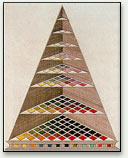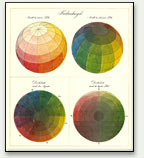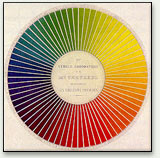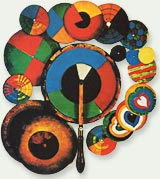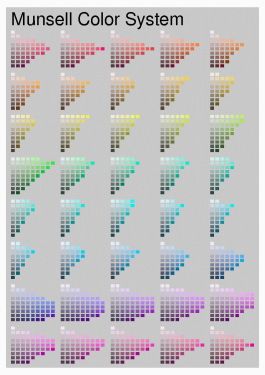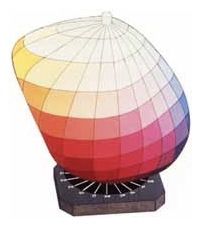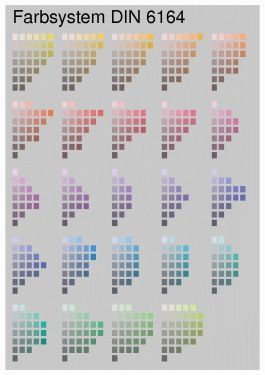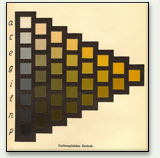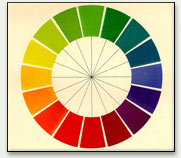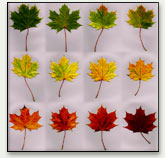A page from the "Causes of Color" exhibit...
How do you represent colors?

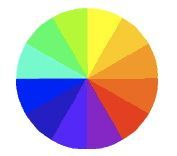
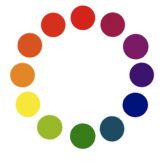
There is debate over which type of color circle or color wheel is most accurate, though there is merit in any color circle arranged in a logical sequence. A color wheel has colors arranged according to a chromatic relationship (visual), and helps us understand the relationships between colors. Primary colors are equidistant, colors opposite one another are complementary, and colors placed beside one another are analogous, mimicking the process that occurs when we blend hues.
There are essentially three different types of color circles.
Conceptually, the oldest of all color circles is based on subtractive color and uses cyan, magenta, and yellow as the primary colors. Often blue, red and yellow are used as the primaries, instead of cyan, magenta and yellow. This variation is historical in origin, and based on the availability of pigments. Painters and printers favor these circles.
Red, green and blue are often the primary colors of choice for scientists, as these colors are based on light (additive color). The Standard Table of the International Commission on Lighting (Commission Internationale de l’Éclairage, CIE) is an example of this type of color atlas.
The third type is based on perception, and is favored by psychologists. It uses the primary colors of red, green, blue, and yellow, which correlate with the colors sensed by the cones in the eye. We perceive red, green, and blue as pure colors. Orange, on the other hand, appears to be a mixture of yellow and red. There are no colors that combine red with green, or yellow with blue, so we perceive them as opposites; there is no such thing as reddish-green, or yellowish-blue. An example of a color system based on perception is the Swedish Natural Color System (NCS).
A color atlas is a useful tool representing the full range of colors. This is achieved by assigning a single point in a space to each color, and arranging similar colors close to each other. This space can then be mapped in a series of single maps, together making up a color atlas. Every possible color can be described by three numerical attributes: hue, saturation and brightness (HSB).
The necessity of ordering colors in space was demonstrated for the first time by the color pyramid of Johann Heinrich Lambert (1772). The color samples were prepared by mixing colored waxes in integral proportions.
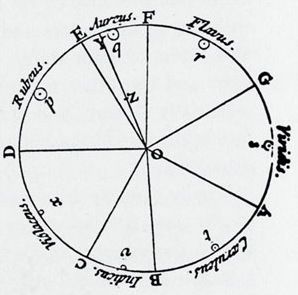
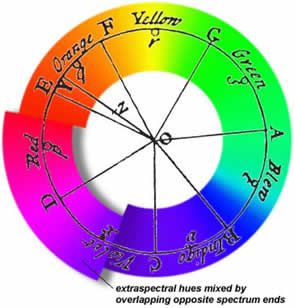
Isaac Newton deepened our understanding of the true nature of light, and was the first to create a color circle. He ordered the colors as follows: red (musical note C), orange (D), yellow (E), green (F), blue (G), indigo (A), and violet (B). Although purple is not a color of the dispersion spectrum, Newton added it to complete the circle, bridging the gap between red and violet.
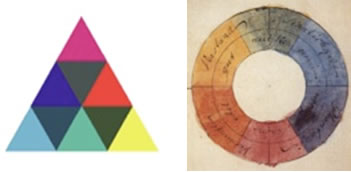
In 1810, Johann Wolfgang Goethe challenged Newton’s established color system, and created his own. He sought a system to govern the use of color in art. At first he intended to create a new color wheel, but found that an equilateral triangle was exactly suited to representing his discoveries. The apex triangles in this diagram are the primary colors used by printers. The secondary triangles between them are the primary colors for painters, and the tertiary colors formed are the dark neutrals. While Newton’s system was based on scientific observation of additive color mixing, Goethe’s method was more conceptual, based on the psychological effects of color. Goethe’s aim was to distill laws of color harmony that incorporated the subjectivity of our color perception, which depends on the object, the light, and how we perceive them. He studied complementary colors, the colors of shadows, and after-images. Goethe identified the origin of our understanding of complementary colors as stemming from the processes within our visual system, rather than being a property of the light that reaches our eyes. His theory opened the door for our modern understanding of color vision.
Color Sphere according to Philipp Otto Runge (1810). Being a painter, the mixing of yellow and blue pigments to obtain green was so familiar to Runge that he refused to recognize green as a pure color. His sphere represents the mixing of pigments. Runge designed the first color solid, a three-dimensional spherical color model ordering all the tints, shades, and hues of colors. Working at the same time as Goethe, he produced a revolutionary theory, arranging the pure hues along the equator. The hues lighten towards a white pole, running longitudinally, and darken towards the black pole. The top views show the poles, and the lower views are cross-sections through the sphere.
Color wheel according to Michel-Eugène Chevreul (1839). Adjacent colors should all show the same degree of difference to each other. He is regarded as being amongst the greatest of colorists.
Rotating top with clipped-on colored discs. This was the first color system based on scientific principles, authored by James Clerk Maxwell around 1850.
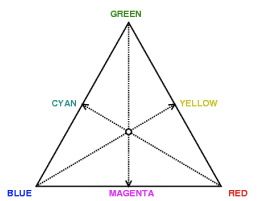
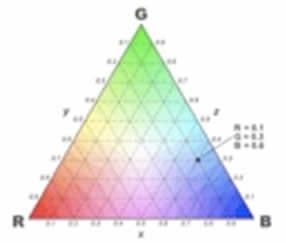
James Clerk Maxwell (1831-1879) produced an equilateral triangle chart. While based on his scientific findings leading to the electromagnetic theory of light, his choice of form is very closely aligned to that of Goethe. They both mix the primaries in the outer triangles to produce the inner colors. However, Maxwell chose red, green, and blue as primaries, and believed he could produce all the known colors from these.
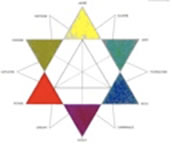
This color circle using triangular color points was devised by Charles Blanc in 1873.
Detail from the color system in The Munsell Book of Color (1929). The color space defined by Albert H. Munsell (1858-1918), a distinguished artist and art teacher, uses three coordinates: brightness increasing from top to bottom, hue, and saturation. The latter correspond to the polar coordinates (angle and radius) in the horizontal plane. Munsell’s resulting color space was irregular and asymmetric. His system served as a foundation for other color order systems. The right image shows a 3D representation of the Munsell model.
Sample page from the color atlas of Wilhelm Ostwald (1916). Black is increasing from top to bottom while hue is increasing from left to right. This is the predecessor of the DIN Color Table.
Color wheel according to Ewald Hering (1920). The four primary colors (red, green, blue, and yellow) are positioned according to their polarity as poles of two perpendicular axes. Intermediate colors are formed by additive mixing from the primary colors. The modern Swedish Natural Color System (NCS) is based on this color wheel.
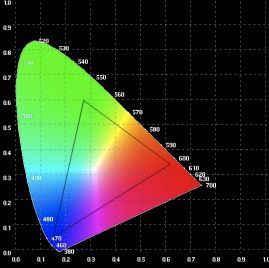

The CIE (Commission Internationale de l'Eclairage) attempted to define an international standard of color measurement in 1931. They created the CIE chromaticity chart, based on Maxwell’s triangle, with primary colors of red, green, and blue. These were used to generate the full range of colors. This chart in its modern format is currently used to measure and quantify the colors produced on computer screens. Pure spectral colors lie on the curved edge, and the area enclosed by the curved line and dashed line includes all visible colors.




